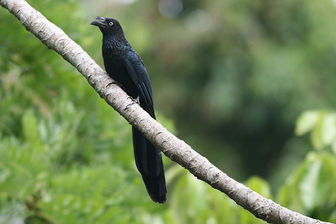Greater Ani
This ani is found in mangrove swamps, semi-open woodland near water, and the edges of forests. It is a seasonal migrant in at least some parts of its range. The nest, built communally by several pairs, is a deep cup lined with leaves and placed usually 2-5 m high in a tree. A number of females lay their chalky deep blue eggs in the nest and then share incubation and feeding. Nests have been found containing 3-10 eggs.

Original source: http://www.flickr.com/photos/arthur_chapman/3103932350/
Author: Arthur ChapmanCamera location
The Greater Ani is classified as Least Concern. Does not qualify for a more at risk category. Widespread and abundant taxa are included in this category.
The Greater Ani, Crotophaga major, is a large near-passerine bird in the cuckoo family. It is a breeding species from Panama and Trinidad through tropical South America to northern Argentina. It is sometimes referred to as the Black cuckoo. This ani is found in mangrove swamps, semi-open woodland near water, and the edges of forests. It is a seasonal migrant in at least some parts of its range. More
The Greater Ani is about 48 cm long and weighs 170 g. The adult is mainly blue-glossed black, with a long tail, massive ridged black bill, and a white iris. Immature birds have a dark iris. This is a very gregarious species, always found in noisy groups. The calls include croaking and turkey-like gobbling kro-koro. The Greater Ani feeds on large insect and even lizards and frogs. References - * BirdLife International (2008). More
Greater Ani is a very gregarious species, often seen in noisy groups. It is larger than other anis species which have dark eyes. Adult male has glossy dark blue-black plumage overall, with conspicuous green feather edges on neck, upper back and shoulders. The upperwing shows greenish iridescence, mainly on the flight feathers. The long, rounded tail has purplish gloss. The head is bluish-black. The massive black bill shows arched ridge at base of the upper mandible. The eyes are yellowish-white. More
Greater aniBirds in Suriname = - Greater ani, suriname Photo of a Greater ani made by N. Takano (personal museum of natural history) in August 2004 in Weg naar Zee, a road to the sea near Paramaribo going from the ricefields and swamps up to the mangrove and the mudflats. The photo clearly shows the light yellow eye of the ani. More
Unlike his smaller cousin the Smooth-billed Ani the Greater Ani is a secretive inhabitant of bushy areas near water and as such is difficult to observe. Its worth persisting though because he is a handsome bird, with an extremely long tail and metallic blue sheen to his upperparts. Adults can be identified by their white iris, but be aware that juveniles often have a dark eye and should be identified by their shape. Greater Anis are migrant, visiting Paraguay in the summer. More
First Record of Greater Ani in Costa Rica Once again, news of a new species for Costa Rica comes from Tortuguero. Following the sighting of a Large-billed Tern (Phaetusa simplex) that was in the area for several weeks in March, local naturalist guide Daryl Loth sent this report in mid-May: "Yesterday (18 May 2003) I was starting out on a tour with a couple from Israel. More
The Greater Ani (Crotophaga major) occurs in the forests of South America, mainly east of the Andes, from Venezuela and Columbia to areas of Brazil, Boliva and northern Argentina. The shot here was taken from a small boat along the Rio Sucusari near Explornapo Lodge, Departmento de Loreto, Peru, in July 2006. The image was taken with a Canon EOS 1D Mark II and EF 300mm F/4 L IS lens and 2X extender. More
Greater Ani calls at rest Crotophaga major (0:36) Alexandre Renaudier XC44121 ?-?-?, French Guiana Greater Ani Calls Crotophaga major (0:17) Bernabe Lopez-Lanus XC48724 16-04-2000, Colombia Greater Ani ? Crotophaga major (3:00) Patrick INGREMEAU XC49634 08-02-2009, French Guiana page 1 © 2005-2010 Xeno-canto Foundation. More
The basic breeding biology of the Greater Ani is fairly well known at the northern limit of its range, but few data exist on population estimates, habitat use, diet, or reproductive parameters in South America. Nothing is known about the effect on breeding populations of habitat destruction in Amazonia (the center of its range). Other forms of habitat alteration, such as water pollution and pesticide use, also may affect ani lifespan and reproductive success. More
The Greater Ani (Crotophaga major) stays in the Caatinga during the rainy season, and a month or two after the rains. It normally keeps close to water (within 100 or 200 meters distance), like a river or a reservoir. In M More
Greater Anis are widely distributed in lowland South America from Colombia to Paraguay, extending into Central America only as far as eastern Panama. Unlike its congeners, which favor open savannah and shrubby pastureland, the Greater Ani is found exclusively in forested habitats adjacent to water. It is most common along the edges of rivers and lakes, where it nests in emergent aquatic vegetation or in tree branches overhanging the water. More
* Greater Ani (Crotophaga major) One individual hidden in the bushes. Hato La Ceibana, Trujillo, Venezuela kperezleon 29 November 2008 1 year ago 2 Sounds 1 recording * calls and song of a flock. More

Original source: Arthur Chapman
Author: Arthur Chapman
Permission: Some rights reserved
